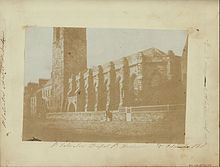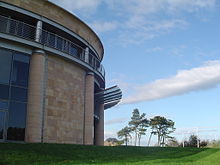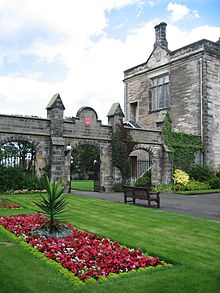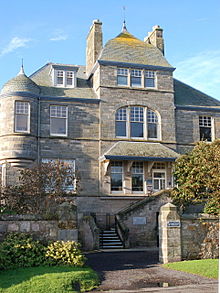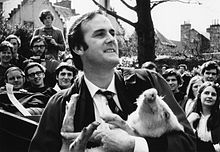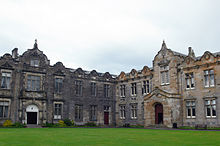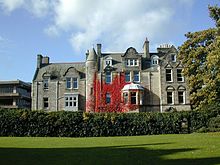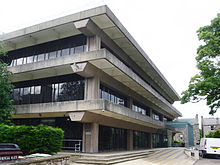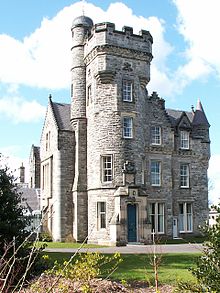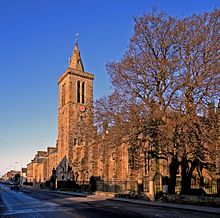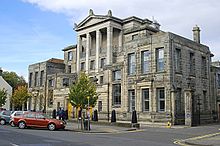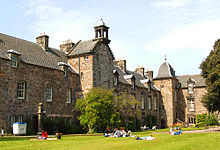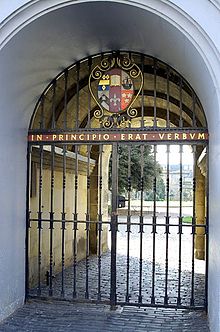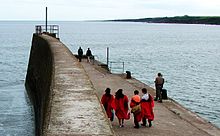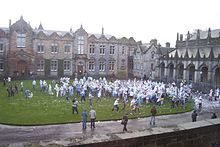
University of St Andrews
Background Information
SOS Children offer a complete download of this selection for schools for use on schools intranets. Click here to find out about child sponsorship.
| University of St Andrews | ||||||||||||||||||||||||||||||||||||||||||||||||||||||||||||||||||||||||
|---|---|---|---|---|---|---|---|---|---|---|---|---|---|---|---|---|---|---|---|---|---|---|---|---|---|---|---|---|---|---|---|---|---|---|---|---|---|---|---|---|---|---|---|---|---|---|---|---|---|---|---|---|---|---|---|---|---|---|---|---|---|---|---|---|---|---|---|---|---|---|---|---|
 University of St Andrews shield |
||||||||||||||||||||||||||||||||||||||||||||||||||||||||||||||||||||||||
| Latin: Universitas Sancti Andreae apud Scotos | ||||||||||||||||||||||||||||||||||||||||||||||||||||||||||||||||||||||||
| Motto | ΑΙΕΝ ΑΡΙΣΤΕΥΕΙΝ (AIEN ARISTEUEIN) (Ancient Greek) |
|||||||||||||||||||||||||||||||||||||||||||||||||||||||||||||||||||||||
| Motto in English | Ever to Excel or Ever To Be The Best |
|||||||||||||||||||||||||||||||||||||||||||||||||||||||||||||||||||||||
| Established | 1410–1413 | |||||||||||||||||||||||||||||||||||||||||||||||||||||||||||||||||||||||
| Endowment | £39.1 million | |||||||||||||||||||||||||||||||||||||||||||||||||||||||||||||||||||||||
| Chancellor | Sir Menzies Campbell | |||||||||||||||||||||||||||||||||||||||||||||||||||||||||||||||||||||||
| Rector | Alistair Moffat | |||||||||||||||||||||||||||||||||||||||||||||||||||||||||||||||||||||||
| Principal | Professor Louise Richardson | |||||||||||||||||||||||||||||||||||||||||||||||||||||||||||||||||||||||
| Academic staff | 926 | |||||||||||||||||||||||||||||||||||||||||||||||||||||||||||||||||||||||
| Admin. staff | 309 | |||||||||||||||||||||||||||||||||||||||||||||||||||||||||||||||||||||||
| Students | 7,775 | |||||||||||||||||||||||||||||||||||||||||||||||||||||||||||||||||||||||
| Undergraduates | 6,169 | |||||||||||||||||||||||||||||||||||||||||||||||||||||||||||||||||||||||
| Postgraduates | 1,606 | |||||||||||||||||||||||||||||||||||||||||||||||||||||||||||||||||||||||
| Location | St Andrews, Fife, Scotland | |||||||||||||||||||||||||||||||||||||||||||||||||||||||||||||||||||||||
| Campus | Urban | |||||||||||||||||||||||||||||||||||||||||||||||||||||||||||||||||||||||
| Colours |
University of St Andrews St Mary's College Bute Medical School St Leonard's College |
|||||||||||||||||||||||||||||||||||||||||||||||||||||||||||||||||||||||
| Affiliations | Universities Scotland Universities UK |
|||||||||||||||||||||||||||||||||||||||||||||||||||||||||||||||||||||||
| Website | st-andrews.ac.uk | |||||||||||||||||||||||||||||||||||||||||||||||||||||||||||||||||||||||
The University of St Andrews (informally St Andrews University or St Andrews) is a research university in St Andrews, Fife, Scotland. It is the oldest Scottish university and the third oldest in the English-speaking world. It was founded between 1410 and 1413, when a Papal Bull was issued by the Avignon Antipope Benedict XIII to a school of higher learning formed by a small group of Augustinian clergy. St Andrews is one of the four ancient universities of Scotland. In post-nominals the university's name is abbreviated as St And (from the Latin Sancti Andreae).
St Andrews is currently ranked as the fourth best university in the UK according to the Guardian University Guide 2013. Its Physics and Astronomy program is ranked second in the UK, after the University of Cambridge, by the Times University Guide. The Times Higher Education World Universities Ranking names St Andrews among the world’s Top 20 Arts and Humanities universities. In the 2012 National Student Survey St Andrews had the highest student satisfaction among Scottish Universities.
The University of St Andrews is located in the small town of St Andrews in rural Fife. In term time over a third of the town's population is either a staff member or student of the university. St Andrews also has a diverse student body with over 30% of its intake consisting of international students from well over 100 countries, and with 15% of the student body coming from North America. The University's sport teams compete in BUCS competitions. The student body is well known for preserving a variety of university traditions.
History
Foundation
The university was founded in 1410 when a group of Augustinian clergy, driven from the University of Paris by the Avignon schism and from the universities of Oxford and Cambridge by the Anglo-Scottish Wars, formed a society of higher learning in St Andrews, which offered courses of lectures in divinity, logic, philosophy, and law. A charter of privilege was bestowed upon the society of masters and scholars by the Bishop of St Andrews, Henry Wardlaw, on 28 February 1411. Wardlaw then successfully petitioned the Avignon Pope Benedict XIII to grant the school university status by issuing a series of Papal Bulls, which followed on 28 August 1413. King James VI also later lent his support by granting the university a royal charter in 1532. A college of theology and arts called St John's College was founded in 1418 by Robert of Montrose and Lawrence of Lindores. St Salvator's College was established in 1450, by Bishop James Kennedy. St Leonard's College was founded in 1511 by Archbishop Alexander Stewart, who intended it to have a far more monastic character than either of the other colleges. St John's College was refounded by Cardinal James Beaton under the name St Mary's College" in 1538 for the study of divinity and law. It was intended to encourage traditional Catholic teachings in opposition to the emerging Scottish Reformation, but once Scotland had formally split with the Papacy in 1560, it became a teaching institution for Protestant clergy. Some of the university buildings that date from this period are still in use today, such as St Salvator's Chapel, St Leonard's College Chapel and St Mary's College quadrangle. At this time, the majority of the teaching was of a religious nature and was conducted by clerics associated with the cathedral.
Development
During the 17th and 18th centuries the university had mixed fortunes and was often beset by civil and religious disturbances. In a particularly acute depression in 1747, severe financial problems triggered the dissolution of St Leonard's College, whose properties and staff were merged into St Salvator's College to form the United College of St Salvator and St Leonard. Throughout this period student numbers were very low; for instance, when Samuel Johnson visited the university in 1773, the university had fewer than 100 pupils, and was in his opinion in a steady decline. He described it as "pining in decay and struggling for life". The poverty of Scotland during this period also damaged St Andrews, as few were able to patronise the university and its colleges, and with state support being improbable, the income they received was scarce.
Modern Period
In the second half of the 19th century pressure was building upon universities to open up higher education to women. In 1876, the University Senate decided to allow women to receive an education at St Andrews at a level roughly equal to the Master of Arts degree that men were able to take at the time. The scheme came to be known as the ' L.L.A. examination' (Lady Literate in Arts). It required women to pass five subjects at an ordinary level and one at honours level, and entitled them to hold a degree from the University. In 1889 the Universities (Scotland) Act made it possible to formally admit women to St Andrews and to receive an education equal to that of male students. Agnes Forbes Blackadder became the first woman to graduate from St Andrews on the same level as men in October 1894, gaining her MA. She entered the university in 1892, making St Andrews the first university in Scotland to admit female undergraduates on the same level as men. In response to the increasing number of female students attending the university, the first women's hall was built in 1896, and was named University Hall.
Up until the start of the 20th century, St Andrews offered a traditional education based on classical languages, divinity and philosophical studies, and was slow to embrace more practical fields such as science and medicine that were becoming more popular at other universities. In response to the need for modernisation and in order to increase student numbers and alleviate financial prblems, the university merged with University College, Dundee in 1897, which had a focus on scientific and professional subjects.
After the incorporation of University College Dundee, St. Andrews various problems generally receded. It became increasingly popular amongst the Scottish upper class to send their children to their country's oldest higher learning institution, and the university's student population rose sharply and soon saw a revival that has been maintained to the present day. The union with University College Dundee ended in 1967 when the college became a independent institution as the University of Dundee. In 1972 the College of St Leonard was reconstituted as a postgraduate institute. In 2009 the University became the first of Scotland's ancient universities to appoint a female principal, Professor Louise Richardson.
Links with the United States of America
The University has had strong historical links with the United States, and several prominent Scottish-Americans have been associated with St Andrews, most notably Andrew Carnegie who was elected Rector, and whose name is given to the Carnegie scholarship. Furthermore three of the signatories of the Declaration of Independence attended or received degrees from St Andrews, including: James Wilson, John Witherspoon and Benjamin Franklin.
The University's American connections have continued into the present day, and it has the highest proportion of its student body made up of American students, among British universities, with around 15% of undergraduates coming from the States. Media reports have indicated that American students may be attracted by the university's comparatively low tuition fees and the similar liberal arts curriculum. There is also a significant St Andrews alumni presence in America, with graduates eligible for membership of institutions such as the Princeton Club of New York and the Algonquin Club.
Governance and administration
As with the other Ancient universities of Scotland, the governance of the university is determined by the Universities (Scotland) Act 1858. This Act created three bodies: the General Council, University Court and Academic Senate (Senatus Academicus).
General Council
The General Council is a standing advisory body of all the graduates, academics and former academics of the University. It meets twice a year and appoints a Business Committee to manage business between these meetings. Its most important functions are to appoint two Assessors to the University Court and elect the University Chancellor.
University Court
The University Court is the body responsible for administrative and financial matters, and is in effect the governing body of the University. It is chaired by the rector, who is elected by the matriculated students of the University. Members are appointed by the General Council, Academic Senate and Fife Council. The President of the Students' Representative Council and Director of Representation are ex officio members of the Court. Several lay members are also co-opted and must include a fixed number of alumni of the University.
Senatus Academicus
The Academic Senate (Latin Senatus Academicus) is the supreme academic body for the University. Its members include all of the professors of the University, certain senior readers, a number of senior lecturers and lecturers and three elected student senate representatives – one from the arts and divinity faculty, one from the science and medicine faculty and one postgraduate student. It is responsible for authorising degree programmes and issuing all degrees to graduates, and for managing student discipline. The President of the Senate is the University Principal.
Office of the Principal
The Principal is the Chief Executive of the University and is assisted in that role by several key officers, including the Deputy Principal, Master of the United College and Quaestor. The principal has responsibility for the overall running of the university and presides over the University Senate.
Rector
In Scotland, the position of Rector exists in the four ancient universities (St Andrews, Glasgow, Aberdeen and Edinburgh) – as well as in the University of Dundee. The post was made an integral part of these universities by the Universities (Scotland) Act 1889. The Rector of the University of St Andrews chairs meetings of the University Court, the governing body of the University; and is elected by the matriculated student body to ensure that their needs are adequately considered by the university's leadership. Through St Andrews' history a number of notable people have been elected to the post, including the actor John Cleese, author and poet Rudyard Kipling and the British Prime Minister Archibald Primrose, 5th Earl of Rosebery.
Faculties and departments
The University is divided into four academic faculties which each encompass a number of schools and departments. A Dean is appointed by the Master of the United College to oversee the day to day running of each faculty. Students apply to become members of a particular faculty, as opposed to any particular school or department. The faculties are: The Faculty of Arts, The Faculty of Divinity, The Faculty of Medicine, and The Faculty of Science.
Academics
Semesters
The University operates a two semester system. The semesters are called Martinmas and Candlemas. The Martinmas semester runs from early September until mid-December, and has 11 teaching weeks. Examinations take place just before Christmas. After examinations and the Christmas vacation there is an inter-semester period when Martinmas semester business is concluded and then the new Candlemas semester begins: this runs from late January to the end of May. Teaching stops at the end of April, followed by a revision and examination period throughout May.
Reputation
| ARWU (2012, national) |
20–30 | |
|---|---|---|
| ARWU (2012, world) |
201–300 | |
| QS (2012/13, national) |
19 | |
| QS (2012/13, world) |
97 | |
| THE (2012/13, national) |
11 | |
| THE (2011/12, world) |
106 | |
| Complete (2013, national) |
6 | |
| The Guardian (2013, national) |
4 | |
| The Sunday Times (2013, national) |
5 | |
| The Times (2013, national) |
6 | |
The independent IpsosMORI National Student Surveys in 2006–2008 commissioned by HEFCE placed it joint third among the UK universities.
The latest national Research Assessment Exercise (RAE 2008) sponsored by the UK government, The Times, The Guardian and The Independent ranked St Andrews as 16th by grade point average and quality index across the units of assessment it submitted. The 2011/2012 Leiden rankings, which assess research quality, placed St Andrews 71st in the world.
Nearly 86% of its graduates obtain a First Class or an Upper Second Class Honours degree. The ancient Scottish universities award Master of Arts degrees (except for science students who are awarded a Bachelor of Science degree) which are classified upon graduation, in contrast to Oxbridge where one becomes a Master of Arts after a certain number of years, and the rest of the UK, where graduates are awarded BAs. These can be awarded with honours; the majority of students graduate with honours.
Admissions
The latest UCAS figures show that there are generally 10 applications per undergraduate place available. The standard offer of a place tends to require five best Highers equivalent to AAAAB, three best A-levels equivalent to AAA or a score of at least 38 points on the International Baccalaureate.
The University has one of the smallest percentages of students (13%) from lower income backgrounds, out of all higher education institutions in the UK. Intake from Independent schools is high (around 40%). The university also has a slightly higher proportion of female than male students with a male to female ratio of 42:58 in the undergraduate population.
Lecture series
To commemorate the university's 600th anniversary the 600th Lecture Series was commissioned in 2011, which brought diverse speakers such as former Prime Minister Gordon Brown, naturalist David Attenborough and linguist Noam Chomsky to St Andrews.
As part of the celebration of the 400th establishment of the King James Library, the King James Library lectures were initiated in 2009 on the subject of 'The Meaning of the Library'.
The Andrew Lang Lecture series was initiated in 1927, and named for alumnus and poet Andrew Lang. The most famous lecture in this series is that given by J. R. R. Tolkien in March 1939, entitled 'Fairy Stories', but published subsequently as ' On Fairy-Stories'.
The computing Distinguished Lecture Series was initiated in 1969 by Professor Jack Cole.
Exchange programmes
The university has several international exchange programs and participates in the Europe-wide Erasmus Programme. Students at St Andrews and The College of William and Mary in Williamsburg, Virginia are offered the option of a four-year, Bachelor of Arts International Honours programme, in which students spend two years at each institution. Students in this program have the option of studying International Relations, English, History, or Economics. The Robert T. Jones Memorial Trust funds exchange programmes with both Emory University in Atlanta, as well as Queen's University and the University of Western Ontario in Canada. The Robert Lincoln McNeil Scholarship is run in conjunction with the University of Pennsylvania. One of the largest exchanges is with the University of California, in which students are study at Berkeley, UCLA and UCSD. The School of International Relations and the School of Modern Languages also oversee an student exchange programme with Paris Institute of Political Studies.
Buildings, collections and facilities
The University of St Andrews is situated in the small town of St Andrews in rural Fife, Scotland. The University has teaching facilities, libraries, student housing and other buildings spread throughout the town. Generally, university departments and buildings are concentrated on North Street, South Street, The Scores, and the North Haugh. The university has two major sites within the town. The first is the United College, St Andrews (also known as the Quad or St Salvator's) on North Street, which functions both as a teaching space and venue for student events, incorporating the Departments of Social Anthropology and Modern Languages. The second is St Mary's College, St Andrews, based on South Street, which houses the Schools of Divinity, Psychology and Neuroscience, as well as the King James Library. Several schools are located on The Scores including Classics, English, History, Philosophy, and International Relations, as well as the Admissions department, and the Museum of the University of St Andrews. North Street is also the site of several departments including, the Principal's Office, The Younger Hall, Department of Film Studies, and the University Library. The North Haugh is principally home to the Natural Sciences such as Chemistry, Physics, Biology, as well as Medicine and the School of Management.
Libraries and Museums
The University of St Andrews maintains one of the largest university library collections in Scotland, which includes significant holdings of books, manuscripts, muniments and photographs. The library collection contains over a million volumes and over two hundred thousand rare and antique books.
The university library was founded by King James VI in 1612, with the donation of 350 works from the royal collection, at the urging of George Gledstanes, the then chancellor of St Andrews, although the libraries of the colleges of St Leonard's College, St Salvator's College and St Mary's College had existed prior to this. From 1710 to 1837 the library functioned as a legal deposit library, and as a result has an extensive collection of 18th century literature.
The library's main building is located on North Street, and houses over 750,000 books. In 2011 the main library building underwent a £14 million re-development. The historic King James library, built in 1643, houses the university's Divinity and Medieval history collections.
In 2012 the University purchased the vacant Martyrs' church on North Street, with the purpose of developing a permanent housing for the special collections department and a postgraduate reading room.
The University maintains several museums and galleries, open for free to the general public. The Museum of the University of St Andrews (MUSA) opened in 2008 and displays some of the highlights of the university's extensive collection of over 100,000 artefacts. It displays objects relating both to the history of the university, such as its collection of 15th century maces, and also unrelated objects, such as paintings by John Opie, Alberto Morrocco and Charles Sims. Several of the university's collections have been recognised as being of 'national significance for Scotland' by Museums Galleries Scotland.
The Bell Pettigrew Museum houses the University's natural history collections. Founded in 1912, it is housed in the old Bute Medical School Building in St. Mary's Quad. Among its collections are the remains of several extinct species such as the Dodo and Tasmanian Tiger as well as fossilised fish from the nearby Dura Den, Fife, which when found in 1859 stimulated the debate on evolution.
Chapels
The University has two collegiate chapels. The chapel of St Salvator's (or "Sallies" as it is affectionately known) was founded in 1450 by Bishop James Kennedy, and today it is a centre of university life. St Salvator's has a full peal of six bells, and is therefore the only university chapel in Scotland suitable for change ringing. The Chapel of St Leonard's is located in the grounds of the nearby St Leonards School. It is the university's oldest building, some parts dating from 1144 and is the smaller of the two chapels. St Salvator's and St Leonard's both have their own choirs, whose members are drawn from the student body.
Student halls
St Andrews is characterised amongst Scottish universities as having a significant number of students who live in university-maintained accommodation. As of 2012, 52% of the student population live in university halls. The halls vary widely in age and character, the oldest, Deans Court dates from the 12th century, and the newest, David Russell Apartments, was built in 2004. They are built in styles from gothic revival to brutalist. All are now co-educational and non-smoking, and several are catered. The University guarantees every first year student a place of accommodation, and many students return to halls in their second, third and final years at St Andrews. Residences include:
- Albany Park
- Andrew Melville Hall
- David Russell Apartments
- Fife Park
- Fife Park Apartments
- John Burnet Hall (known as Atholl)
- McIntosh Hall (known as Chattan)
- Agnes Blackadder Hall
- St Regulus Hall
- St Salvator's Hall
- University Hall
- Gannochy House (Postgraduate only)
- Deans Court (Postgraduate only)
- Stanley Smith House & Angus House (Postgraduate only)
Student life
Students' association
The University of St Andrews Students' Association is the organisation which represents the student body of the University of St Andrews. It was founded in 1864, and is one of the oldest students' unions in the world. It comprises the Students' Representative Council (SRC) and the Students' Union Council. The Students Association has 9 subcommittees: Societies Committee, Charities Campaign, Union Debating Society, STAR (St Andrews Radio), Mermaids Productions, LGBT, Design Team, SVS (Student Voluntary Service). Every matriculated student is automatically a member of each subcommittee.
The Students' Association Building (informally known as the Union) is located on St Mary's Place, St Andrews. Union facilities include a Blackwells bookshop, a bar and the University's Student Support Services. In 2013 the Students' Association Building is scheduled to undergo a £12 million refurbishment. The Students' Association is affiliated to, and a founding member of, the Coalition of Higher Education Students in Scotland but unlike many other students' unions in the UK is not a member of the National Union of Students, having most recently rejected membership in a referendum in November 2012.
Clubs and Societies
St Andrews is home to over 140 student societies which cover a wide range of interests.
All matriculated students are members of the Union Debating Society, a student debating society that holds weekly public debates in Lower Parliament Hall, often hosts notable speakers, and participates in competitive debating in both national and international competitions. Founded in 1794, it claims to be the oldest continuously-run student debating society in the world.
There is a strong tradition of student media at St Andrews. The University's two newspapers are The Saint, a fortnightly publication that holds a rare financial and editorial independence from both the Students' association and the University itself, and The Stand, an online publication founded in 2011. There are also a number of smaller student publications including The Tribe, a student-run magazine and The Regulus, a student magazine focusing on politics and current affairs. In addition to this there are several student led-academic journals, most notably, Stereoscope Magazine which is focused on student photography and raising awareness of the university's historic photographic collection, Ha@sta, an annual journal for those interested in art history, Aporia, the journal of the philosophy society, and the Postgraduate Journal of Art History and Museum Studies. The University's radio station is STAR radio, an online station that broadcasts 24/7 during term time. The Sinner is an independent website and discussion forum set up by students of the university.
The University's Music Society comprises many student-run musical groups, including the University's flagship Symphony Orchestra, Wind Band, and Chorus. One of the oldest choirs in the University is the St Andrews University Madrigal Group which performs a concert each term and has an annual summer tour. The ' A Cappella Society' represents all four a cappella groups in St Andrews: The Other Guys, The Alleycats, The Accidentals and The Hummingbirds. From 2009–2011, all four of these groups participated in The Voice Festival UK(VF-UK) competition, and The Other Guys, The Accidentals and The Alleycats all reached the London final. In 2011, The Other Guys released a music video onto YouTube, entitled Royal Romance, a tribute to the wedding of Prince William and Catherine Middleton, which earned them significant recognition in both Scottish and international media.
Student theatre at the University of St Andrews is funded by the Mermaids Performing Arts fund. There are regular dramatic and comedic performances staged at the Barron theatre. Blind Mirth is the university's improvisational theatre troupe, which performs weekly in the town, and annually takes a production to the Edinburgh Fringe Festival.
The Kate Kennedy Club plays a significant role in the life of the university, maintaining University traditions like the Kate Kennedy Procession, in which students parade through the town dressed as eminent figures from the university's history, and organising social events like the opening and May balls. Founded in 1926, the club is composed of sixty matriculated students, who are selected by the club's members. The club has received criticism from the University principal Louise Richardson and alumnus the Duchess of Cambridge Kate Middleton over its previously male-only admission policy. In 2012, the club decided to allow female students to join.
Athletics
The University of St Andrews Athletic Union is the Student representative body for sport. Established in 1901, it is affiliated to BUCS and encompasses several sport clubs, who compete at both a recreational and high-performance level. One of the most notable clubs is the University of St Andrews Rugby Football Club, which played a pivotal role in shaping the sport and has produced Scottish international players such as J. S. Thomson and Alfred Clunies-Ross.
Traditions
Sponsio Academica
In order to become a student at the University a person must take an oath in Latin at the point of matriculation, called the Sponsio Academica, although this tradition now has been digitised and is agreed to as part of an online matriculation process.
Nos ingenui adolescentes, nomina subscribentes, sancte pollicemur nos preceptoribus obsequium debitum exhibituros in omnibus rebus ad disciplinam et bonos mores pertinentibus, Senatus Academici autoritati obtemperaturos, et hujus Academiae Andreanae emolumentum et commodum, quantum in nobis sit, procuraturos, ad quemcunque vitae statum pervenerimus. Item agnoscimus si quis nostrum indecore turbulenterve se gesserit vel si parum diligentem in studiis suis se praebuerit neque admonitus se in melius correxerit eum licere Senatui Academico vel poena congruenti adficere vel etiam ex Universitate expellere.
In English:
We students who set down our names hereunder in all good faith make a solemn promise that we shall show due deference to our teachers in all matters relating to order and good conduct, that we shall be subject to the authority of the Senatus Academicus and shall, whatever be the position we attain hereafter, promote, so far as lies in our power, the profit and the interest in our University of St Andrews. Further, we recognise that, if any of us conducts ourselves in an unbecoming or disorderly manner or shows insufficient diligence in their studies and, though admonished, does not improve, it is within the power of the Senatus Academicus to inflict on such students a fitting penalty or even expel them from the University.
Gowns
One of the most conspicuous traditions at St Andrews is the wearing of academic dress, particularly the distinctive red undergraduate gown of the United College. Undergraduates in Arts and Science subjects can be seen wearing these garments at the installation of a Rector or Chancellor, at chapel services, on 'Pier Walks', at formal hall dinners, at meetings of the Union Debating Society or giving tours to prospective students and visitors as well as on St Andrews day, where recently many students wear their gown throughout the entire day. Divinity students wear a black undergraduate gown. (See Academic dress of the University of St Andrews.)
Bejant
Bejant was a term used to refer to first year male students; females being described as Bejantines. However, it is no longer in regular use, having been replaced by the term 'fresher'. A second-year student is known as a Semi, student in their third year may be referred to as a Tertian, and in their final year as a Magistrand. These terms are thought to be unique to St Andrews. When wearing their traditional red gowns, students in each year may be identified according to the way they wear their gowns.
Academic parents
The students of the University enjoy an unusual family tradition designed to make new students feel at home and build relationships within the student body. Traditionally, a Bejant or Bejantine acquires academic parents who are at least in their third year as students. These older students act as informal mentors in academic and social matters and it is not uncommon for such academic family ties to stretch well beyond student days. Tradition has it that a Bejant may ask a man to be his Senior Man but must be invited by a woman who is prepared to be his Senior Woman. Similarly, a Bejantine may ask a male to be her Senior Man but there is no overt rule regarding how she acquires a Senior Woman. The establishment of these relationships begins at the very start of the first semester – with the aim of being in place ahead of Raisin Weekend.
Raisin Weekend
Raisin Weekend celebrates the relationship between the Bejants/Bejantines (First-Year students) and their respective Academic Parents who, in St. Andrews' tradition, guide and mentor them in their time at the University. It is traditionally said that students went up to study with a sack of oatmeal and a barrel of salt-herring as staple foods to last them a term and that therefore anything more exotic was seen as a luxury. In return for the guidance from academic parents a further tradition sprang up of rewarding these "parents" with a pound of raisins. Since the 19th Century the giving of raisins was steadily transformed into the giving of a more modern alternative – such as a bottle of wine. In return for the raisins or equivalent present the parents give their "children" a formal receipt – the Raisin Receipt – composed in Latin. Over time this receipt progressively became more elaborate and often humorous. The receipt can be written on anything and is to be carried everywhere by the Bejant/Bejantine on the morning of Raisin Monday until midday.
Raisin Weekend is held annually over the last weekend of November. Affairs often begin with a tea party (or similar) thrown by the mother(s) and then a pub-crawl or house party led by the father(s). It is fairly common for several academic families to combine in the latter stages of the revels. At midday all the First-Years gather in Quad of St Salvator's College to compare their receipts and also to be open to challenge from older students who may look for errors in the Latin of the receipt (an almost inevitable occurrence). Upon detection of such error(s) the bearer may be required to sing the Gaudie. In recent years the gathering has culminated in a shaving foam fight. Raisin Weekend has also become synonymous with binge drinking and a certain amount of humiliation of "academic children", commonly involving embarrassing costumes or drinking games. The University Students' Association provides a special First Aid hotline for Raisin Weekend.
Cobblestones
Situated around the town of St Andrews are cobblestone markings denoting where Protestant martyrs were burnt at the stake. To students, the most notable of these is the cobblestone initials "PH" located outside the main gate of St Salvator's College. These cobblestones denote where Patrick Hamilton was martyred in 1528. According to student tradition, stepping on the "PH" will cause a student to become cursed, with the effect that the offender will fail his or her degree and so students are known to jump over the cobblestones when passing. Aside from the May Dip, an older tradition is that the remedy for this is to walk three times round the post at the end of the pier.
May Dip
The May Dip is a student tradition held annually at dawn on May Day. Students stay awake until dawn, at which time they collectively run into the North Sea to the sound of madrigals sung by the University Madrigal Group. In 2011 the event was 'officially' moved by the Students' Association to East Sands in response to concerns for health and safety in its former location on Castle Sands.
University of St Andrews people
Philosophy and academia
- Robert Balfour, philosopher
- G. W. S. Barrow, arguably the most prominent Scottish medievalist of the last century
- Andrew Bell (educationalist), Scottish Anglican priest and educationalist, founder of Madras College
- Lionel Butler First Professor of Medieval History (1955) and later Vice-Principal of the University. Principal of Royal Holloway College, University of London (1973–1981)
- Stephen Haliczer, historian
- Kieron O'Hara, philosopher and political writer
- Russell Kirk, American political theorist, historian, and fiction author
- Walter Perry, Lord Perry of Walton, first Vice-Chancellor of the Open University
- Dominic Sandbrook, historian and author
- Lawrence Stenhouse, educational researcher
- Eric Anderson, provost of Eton College
- Robert Archibald Armstrong, lexicographer
Business and law
- Lord Colonsay, former Lord Advocate and Lord Justice General
- Lord Cullen, former Lord President of the Court of Session and Lord Justice General
- Lord Eassie, Judge of the Inner House of the Court of Session
- Sir John Rose (Rolls-Royce), CEO of Rolls-Royce plc
- Olivier Sarkozy, senior investment banker and half brother of the former French President, Nicolas Sarkozy
- Alexander Balfour, merchant and founder of Balfour Williamson
Politics and public affairs
- Henry Balnaves, Scottish politician and religious reformer
- John Hamilton-Gordon, 1st Marquess of Aberdeen and Temair, Scottish politician and Governor General of Canada
- Marco Biagi MSP, SNP Member of the Scottish Parliament
- Edgar Paul Boyko, Attorney General for the State of Alaska under Governor Walter Hickel
- Angie Bray MP, Conservative politician
- Malcolm Bruce, Liberal Democrat MP
- Thomas Bruce, 7th Earl of Elgin, diplomat
- Eamonn Butler, director and co-founder, Adam Smith Institute
- Archibald Campbell, 1st Marquess of Argyll, 8th Earl of Argyll, chief of Clan Campbell
- John Campbell, 1st Baron Campbell, Liberal politician and lawyer
- Christopher Chope MP, Conservative politician
- Michael Forsyth, former Secretary of State for Scotland
- Barry Gardiner, Labour Party politician, MP
- Marlyn Glen, Scottish Labour Party politician, and Member of the Scottish Parliament for North East Scotland region since 2003.
- James Graham, 1st Marquess of Montrose, royalist military commander
- John Graham, 1st Viscount of Dundee, Jacobite military commander, "Bonnie Dundee"
- John Campbell, 9th Duke of Argyll, British nobleman and was Governor General of Canada from 1878 to 1883
- Michael Fallon MP, Conservative politician
- Arthur Hobhouse, architect of the system of National parks of England and Wales, MP
- Mark Lazarowicz, Labour Party politician
- James Younger, 5th Viscount Younger of Leckie, Conservative politician
- John MacGregor, Baron MacGregor of Pulham Market, Conservative politician
- Jean-Paul Marat, Radical pro-revolutionary journalist during the French Revolution
- Lewis Moonie, Baron Moonie, Labour Party politician, MP
- Madsen Pirie, founder, Adam Smith Institute
- Lyon Playfair, 1st Baron Playfair, scientist and Liberal politician
- George Reid, Scottish National Party politician and second Presiding Officer of the Scottish Parliament
- Alex Salmond, First Minister of Scotland and leader of the Scottish National Party
- John Sawers, British Ambassador to the UN and Director of MI6
- Alex Singleton, Political commentator and former president of the Globalisation Institute
- Catherine Stihler, Labour Party politician
- Jamie Stone, Liberal Democrat Member of the Scottish Parliament
- Desmond Swayne MP, Conservative politician
- Hugo Swire MP, Conservative politician
- James Wilson, signatory of the United States Declaration of Independence
- Hikmat Abu Zayd, first Egyptian female cabinet member
- Robert F. Thompson, member of the Arkansas senate
- Richard Arthur, member of Parliament of New South Wales
Religion

- David Beaton, Cardinal Archbishop of St Andrews
- James Beaton, Scottish church leader, the uncle of Cardinal David Beaton
- George Buchanan, scholar, theologian and playwright
- The Reverend Alexander Duff, missionary and founder of Scottish Church College, Calcutta
- Thomas Chalmers, theologian and leader of the Free Church of Scotland
- Colin Falconer, 17th century Scottish minster and bishop
- George Gillespie, Scottish theologian
- Patrick Hamilton, Protestant reformer, early martyr of the Scottish Reformation+
- Alexander Henderson, theologian
- John Knox, theologian, leader of the Protestant Reformation who is considered the founder the Church of Scotland
- Andrew Melville, scholar and theologian and religious reformer
- John Munro of Tain, dissenter opposing reforms of James VI.
- Victor Premasagar, Old Testament scholar and Moderator of the Church of South India
- Klyne Snodgrass, American scholar and theologian
- Sheila Watson, archdeacon
- John Witherspoon, theologian, President of Princeton University and signatory of the U.S. Declaration of Independence.
- John Adamson , Minister and Moderator of the General Assembly of the Church of Scotland
- Christopher Woods, Chaplain of Christ's College, University of Cambridge
- Patrick Adamson, Divine and Archbishop of St Andrews
- Matthew Armour, Free Church of Scotland minister
- Robert Arnot, presbyterian minister
Royalty
- King James II of Scotland
- The Duke of Cambridge
- The Duchess of Cambridge
- Sheikh Zayed bin Sultan bin Khalifa Al Nahyan
- James Ogilvy
- William Douglas, 10th Earl of Angus
Sciences

- Edward Jenner, Doctor of Medicine, first doctor to introduce & study the Smallpox vaccine
- James Gregory, astronomer and mathematician, inventor of the reflecting telescope
- John Napier, mathematician, inventor of logarithms
- Alan MacDiarmid, Nobel prize winner in Chemistry
- Sir James Black, Nobel prize winner in Medicine
- Walter Haworth, Nobel prize winner in Chemistry
- James Irvine, chemist, isolated the first methylated sugars, trimethyl and tetramethyl glucose
- Francis Robert Japp, British chemist who discovered the Japp–Klingemann reaction in 1887.
- Joseph Bancroft, surgeon and parasitologist born in England, who emigrated to Australia
- Alexander Berry, explorer, Australian pioneer and settler of Coolangatta
- Sir Douglas Black, physician and the author of Black Report
- Saba Douglas-Hamilton, British wildlife conservationist and television presenter
- John Garrow, honorary consultant physician, chairman of HealthWatch, Joint Advisory Committee on Nutrition Education and Association for the Study of Obesity
- Robert Whytt, President of the Royal College of Physicians in Edinburgh, wrote book on diseases of the nervous system
- John Arbuthnot, physician, satirist, and creator of the character John Bull
- Kay Redfield Jamison, clinical psychologist and writer
- Patrick Abercromby, physician and antiquarian
- John Adamson, physician and pioneer photographer
- Adam Anderson , physicist and encyclopedist
- John Hutton Balfour, botanist
Other
- James Crichton, polymath, the original "Admirable Crichton"
- Findlay S. Douglas, former President of the United States Golf Association
- Anthony Dickson Home, Served as Surgeon General of the British Army. Awarded the Victoria Cross
- John Honey, student who rescued five men from a ship
- Sir Chris Hoy, World, Olympic and Commonwealth Cycling Champion
- Charles B. Macdonald, a major figure in early American golf
- William Gordon Rutherfurd, Commander of HMS Swiftsure at the battle of Trafalgar
- Barney White-Spunner, Commander of the British Field Army
- George Kennedy Young, Deputy Director of MI6 and Merchant Banker
- Danny Blanchflower, Northern Ireland international footballer
In popular culture
The University of St Andrews has appeared in or been referenced by a number of popular media, including film and literature. St Andrews appeared in the 1775 Travel narrative A Journey to the Western Islands of Scotland by Samuel Johnson, in which he visited the University. The 1956 romance novel, Girl in May by Bruce Marshall is set in St Andrews. In the Enid Blyton novels Malory Towers, the main heroine Darrell Rivers plans to attend the University of St Andrews after Sixth Form with some of her fellow characters. The student hall, Andrew Melville Hall, was used for location shooting of the film adaptation of Kazuo Ishiguro’s novel, Never Let Me Go starring Keira Knightley. West Sands Beach in St Andrews was used as a location for the film Chariots of Fire, the scene, in which several of the main characters run along the beach, has become widely recognised and one of the most famous scenes in British film history.
